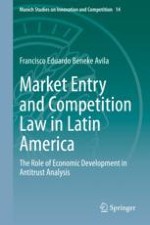2021 | OriginalPaper | Chapter
9. Comparative Analysis: Do Latin American Countries Follow the EU or US Standards for Entry Analysis?
Author : Francisco Eduardo Beneke Avila
Published in: Market Entry and Competition Law in Latin America
Publisher: Springer Berlin Heidelberg
Activate our intelligent search to find suitable subject content or patents.
Select sections of text to find matching patents with Artificial Intelligence. powered by
Select sections of text to find additional relevant content using AI-assisted search. powered by
